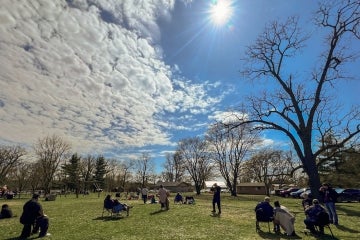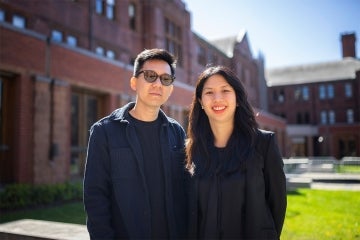
IMAGINE health clinic: U of T students serve city's most marginalized citizens
Published: December 2, 2014
Imagine a clinic providing free health care to Toronto’s most vulnerable residents: people with no fixed address, health insurance or ID. Too bold, utopian, or disruptive?
Not for a group of University of Toronto students.
In 2007, U of T students from a variety of health profession programs came together to form the Interprofessional Medical and Allied Groups for Improving Neighbourhood Environment (IMAGINE). And by 2010, with support from faculty and community partners, the IMAGINE clinic was open and offering medical, nursing, pharmacy and social work services.
In 2012, physiotherapy was integrated and the clinic became a recognized Centre for Interprofessional Education credit program.
“It seemed like a really unique opportunity for a student to get involved both first line interacting with patients and interacting in a team with all the other professions that you might see in the real world,” says Claire Hooper, a third-year pharmacy student volunteering at IMAGINE.
“It’s also a very unique, underserved patient population, so it’s a great opportunity to be able to help, especially as a student.”
 Students volunteer at the clinic (pictured at right) for three consecutive Saturdays, followed by a reflection day. They work in teams of five students drawn from each health discipline, supervised by five preceptors – licensed healthcare practitioners, who are also volunteering at the clinic.
Students volunteer at the clinic (pictured at right) for three consecutive Saturdays, followed by a reflection day. They work in teams of five students drawn from each health discipline, supervised by five preceptors – licensed healthcare practitioners, who are also volunteering at the clinic.
Working in pairs, the students start the visit, take the patient’s history, perform a physical exam, interpret information and present the case to the rest of the team.
Christopher Wang, now in his second year of medicine, likens the experience to doing a puzzle. “It’s hard to know what to expect when we walk through the door. We try to gather all the pieces and then we go back and debrief with the team and that’s where we start putting the puzzle together. With the expertise of everybody sitting around that table we try to figure out what this patient is here for and what we can do to help.”
In the process, students also learn to write clinical notes, collaborate with other disciplines and develop a treatment plan. And they gain confidence along the way.
“Because they are in pre-clinical years, most med students have not yet been told to “go get your patient and bring them into the room,” says Norma C. Carter, a family doctor/general practitioner, who has been volunteering at IMAGINE as a physician preceptor over the last three years. “By the third clinic, the same student is confidently giving polished, organized presentations and developing plans with their fellow students.”
More than 200 clients are assessed and treated at IMAGINE every year. Many patients come in for physiotherapy, because it’s generally not covered by health plans, but students also see people suffering from common ailments to infections to mental health issues and they treat them all.
Wang’s fondest memory is of a patient who came in with an infected thumb. After examining it and debriefing with the team, the preceptor came in and together they had a good chat with the patient, who turned out to be an IV drug user trying hard to overcome his addiction.
“After explaining to the patient that the thumb is related to his drug use he seemed to have more of an incentive to keep on working on that aspect of his life,” says Wang. “That was very memorable because people will often question how much we can do in a one-hour session like this, and I think there’s actually a lot we can do in terms of getting people back on the right track even.”
Such encounters teach students that patients from marginalized populations have the same health issues as other patients but with additional challenges that make management much more complex at times, says Carter. “They’re getting intensive exposure to the social determinants of health, while also learning not to be afraid of a challenging population.”
Wang agrees. “As training medical students it’s very easy to be only shown the best cases, high blood pressure, etc. But that’s not at all what the health scene of the city is like. I think it’s important for students to see that.”
Hooper concurs: “It makes you a better health practitioner.”

(Above: team members discuss case with preceptors.)
The benefits from IMAGINE’S open, enthusiastic and collaborative care extend beyond the students and the city population they treat, organizers say. Preceptors say they – along with the patients they see in their regular practice outside IMAGINE – also benefit from the inter-professional learning opportunities IMAGINE provides.
Like Carter, Vivian Law is among the 100 preceptors from medicine, nursing, pharmacy, physiotherapy, and social work volunteering at the clinic this year. She started volunteering at IMAGINE as a pharmacy student and has been volunteering as a pharmacy preceptor for the last three years.
Working alongside preceptors and students from other professions, you learn together, Law says. And when students go out to do practice, they’ll be better equipped to interact with other healthcare professionals, she says, and they’ll know what information and support they can get for the patient.
“That’s important because the underprivileged come in with multiple common diseases and issues, so it’s good that the students get to look at the patient in a more holistic view.”
Sandra*, returning to the clinic for a follow-up visit about her back pain, is happy with the service she is getting.
“I like when they show me some exercises or give me a handout so I can practice at home,” she says. “They really want to keep me on track.”
The clinic is open every Saturday except on long weekends and holidays from 10am to 2pm. (Learn more about volunteering, supporting or accessing the clinic.)
*Name changed for privacy reasons.
Jelena Damjanovic writes about communities and urban outreach for U of T News.



